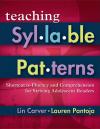
Students who fall into the second group can read some sight words, but when they come across a new word they cannot figure it out. They simply don’t “get” letter patterns. They haven’t internalized the six basic types of English syllables (Rippel, 2008), and without that skill they are unable to decode new words. Their reading is not fluent—it’s labored and unsatisfying. Their oral reading performance in class embarrasses them, and to avoid the feeling of failure, they stop participating in class and avoid reading at home (Torgensen, 2004).
Consequently, these students do not have much experience with reading, and their exposure to new vocabulary words, text organization, and academic language is limited (Moats, 2001). Without practice in reading, their comprehension, spelling, and writing skills decline dramatically over time. What may have begun as a fairly simple phonological or word recognition deficit often becomes a debilitating language and comprehension problem that affects both spoken and written language (National Institute for Literacy, 2007).
Of course, these students should have mastered these basic reading skills a long time ago, so we teachers sometimes forget to check to make sure that they really know how to read. Or we may not think it’s really our job to teach older students how to read. We hope, unfortunately too often in vain, that they will “get” it at some point on their own. And what secondary teacher has the time or patience to go back and teach those phonemic drills from early reading days?
Drills don’t work well with secondary students anyway. But games and activities do. Instead of syllable pattern drills, Teaching Syllable Patterns organizes the six basic English syllable patterns into games and activities that can be easily inserted into any teacher’s day. Playing games and doing different activities helps move these skills to the automatic level so that students can pronounce the words they see more quickly. This will enable them to read the passages smoothly and hold onto their meaning. By taking the decoding to an automatic level, students can focus their attention on making meaning from the text.
Try this sample mini-lesson and activity to help your students master the CV syllable.
